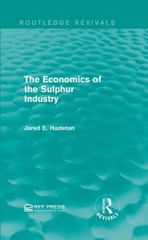Question
You work for The Bee Sneeze, a company that produces organic, free range, gluten-free honey (Our Bee Nose What's Good!). You've collected data on monthly
You work for The Bee Sneeze, a company that produces organic, free range, gluten-free honey ("Our Bee Nose What's Good!"). You've collected data on monthly sales (S, number of jars of honey sold per month) the price of your jar of honey (P, in dollars), and the population size in the different cities in which your company has retail locations (N, number of people; you currently only have one establishment in each city). You estimate the following regression model: S = a + bP + cN. In your regressions, you usually look for a 5%-or-better level of confidence.
a.What signs do you expect for a, b, and c?
b.Your regression yields the following results:
Adjusted R Square
0.640
Independent Variables
Coefficients
Standard Error
t Stat
P-value
Intercept
13103
2555
5.129
0.00368
P
-612.10
169.16
-3.618
0.01524
N
0.0076
0.0057
1.327
0.24174
Interpret what these coefficients mean.
c.Does price have a statistically significant effect on sales?
d.Does population have a statistically significant effect on sales?
e.What portion of the total variation in sales remains unexplained?
f.The Bee Sneeze is considering selling in a new city, where the population is 187,500, and setting its jar of honey price at $13.50. What level of monthly sales would you expect in this new city (rounded to the nearest unit)?
2.Your company has estimated its total cost to be TC = 52,500 + 12Q + 0.008Q2; its marginal cost is thus MC = 12 + 0.016Q, where Q is the quantity of units produced and TC is in dollars. Since your market is relatively competitive, your company is able to sell its output for $84 each (which thus yields MR = 84 and TR = 84Q).
a.Produce a chart in Excel showing TC and TR with Q on the horizontal axis. Have Q go from 0 to 10,000 units (each row of your Q column can increase by a relatively large number so that your table isn't huge). Produce a second chart showing MC and MR with Q again on the horizontal axis.
b.What is the optimal level of output for your company to produce/sell? What is the marginal revenue from the last unit sold?
c.What are the total revenue, total cost, and profit (net benefit/net revenue/etc.) from selling the optimal number of units?
d.An eager intern at your company suggests that, since the company earns $84 revenue for each unit sold, then the company could make still more profit by selling more than the level chosen in part b; why would your company not want to produce and sell more output than the level you chose in part b?
Step by Step Solution
There are 3 Steps involved in it
Step: 1

Get Instant Access to Expert-Tailored Solutions
See step-by-step solutions with expert insights and AI powered tools for academic success
Step: 2

Step: 3

Ace Your Homework with AI
Get the answers you need in no time with our AI-driven, step-by-step assistance
Get Started


